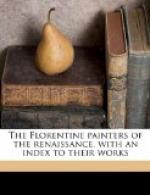IV.
[Page heading: MASACCIO]
Giotto born again, starting where death had cut short his advance, instantly making his own all that had been gained during his absence, and profiting by the new conditions, the new demands—imagine such an avatar, and you will understand Masaccio.
Giotto we know already, but what were the new conditions, the new demands? The mediaeval skies had been torn asunder and a new heaven and a new earth had appeared, which the abler spirits were already inhabiting and enjoying. Here new interests and new values prevailed. The thing of sovereign price was the power to subdue and to create; of sovereign interest all that helped man to know the world he was living in and his power over it. To the artist the change offered a field of the freest activity. It is always his business to reveal to an age its ideals. But what room was there for sculpture and painting,—arts whose first purpose it is to make us realise the material significance of things—in a period like the Middle Ages, when the human body was denied all intrinsic significance? In such an age the figure artist can thrive, as Giotto did, only in spite of it, and as an isolated phenomenon. In the Renaissance, on the contrary, the figure artist had a demand made on him such as had not been made since the great Greek days, to reveal to a generation believing in man’s power to subdue and to possess the world, the physical types best fitted for the task. And as this demand was imperative and constant, not one, but a hundred Italian artists arose, able each in his own way to meet it,—in their combined achievement, rivalling the art of the Greeks.




